Stuart Aken's Blog, page 237
March 22, 2014
The 12 Days of Launch Countdown: Day 8
 Picture courtesy of https://openclipart.org/ 8 days to go before the launch of A Seared Sky: Joinings. Excitement rising every day.
Picture courtesy of https://openclipart.org/ 8 days to go before the launch of A Seared Sky: Joinings. Excitement rising every day. In the spirit of the well-loved seasonal song, I offer you the 12 days of countdown.
Mine are in reverse order.
On the eighth day of countdown, I give to you
Eight exciting ethnics:
Tumalind – clever, able, beautiful and belovedAklon Dji – renegade, fearless, handsome and desirableFeldrark – great, shrewd, just and tenaciousJodisa Li – bright, determined, spoilt and manipulativeOkkyntalah – innocent, brave, selfless and attractiveAglydron – fanatical, conservative, pious and sternIvdulon – intelligent, farsighted, sensitive and inventiveDagla Kaz – cruel, hypocritical, driven and unwavering
These are just a few of the adventurers who people my invented world. They love, fight, sing, rescue, joke, hate, seduce and kill. But which of them does which of these things? All is revealed in the trilogy. Book 1, A Seared Sky: Joinings, published by Fantastic Books Publishing, is launched as paperback and ebook on 30th March. And you can join in the fun on the day by clicking this link.

Published on March 22, 2014 02:32
March 21, 2014
The 12 Days of Launch Countdown: Day 9
 Only 9 days before the launch of A Seared Sky: Joinings. Excitement rising as the day approaches. In the spirit of that seasonal song, I offer you the 12 days of countdown. Mine, though, are in reverse order. Here, on the ninth day, I give you:
Only 9 days before the launch of A Seared Sky: Joinings. Excitement rising as the day approaches. In the spirit of that seasonal song, I offer you the 12 days of countdown. Mine, though, are in reverse order. Here, on the ninth day, I give you:Nine nautical names.
Sophraq Sea – briny splashes out of the islandIbasim Sea – short crossing on the way homeSea of Llahkan – are there pirates?Bay of Ffosh – at the edge of the known worldTulak Sea – carrying a precious cargoYaalh Bay – a mysteryShylnah Sea – watch out for the deadly reef and the island of fireSouthern Ocean – bringing trade and strange customs from the far side of the worldSho Bay – almost home
These seas wash their waves on the shores of my invented world. Follow the various groups, as they sail in search of glory, or to right wrongs, on the map. Voyage with them to learn their joys, their sorrows, their desires, their secrets and their plans. All is revealed in the trilogy. Book 1, A Seared Sky: Joinings, published by Fantastic Books Publishing, is launched as paperback and ebook on 30th March. And you can join in the fun on the day by clicking this link.Related articles
 The 12 Days of Launch Countdown: Day 10
The 12 Days of Launch Countdown: Day 10

Published on March 21, 2014 00:20
March 20, 2014
The 12 Days of Launch Countdown: Day 10
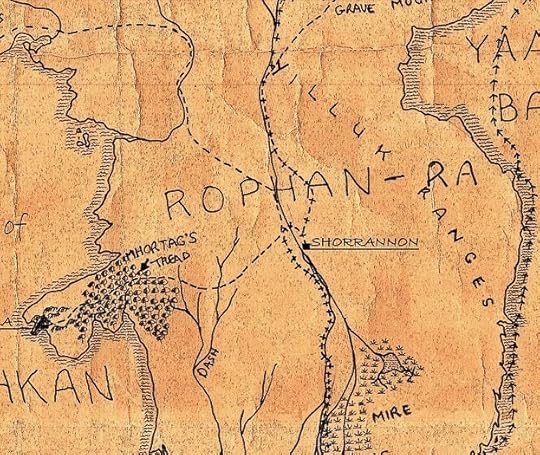 Only 10 days before the launch of A Seared Sky: Joinings, and I’d like to share my excitement withyou.
Only 10 days before the launch of A Seared Sky: Joinings, and I’d like to share my excitement withyou. In the spirit of the old seasonal song, I’m offering you the 12 days of countdown.
Mine, though, are in reverse order.
Ten torrid territories:
Muhnilahm – island home where it all beginsNiphralon – savage land that some are forced to visitAashnon – the edge of the known world – a mysteryChoshinahm – the ancient homeland; hope for someTohltaz – desert land where visitors tread with careDeztal – just passing throughCushlanah – wide-open spaces, full of the unknownRophan-Ra – where three great cities vie for prominenceKabalyt – land of threat and promiseNdagaal – outpost at the end of an adventure
These are some of the regions of my invented world. The map displays them so that you can follow the progress of the various groups as they travel in search of answers, glory, or to rescue loved ones. Trek with them to learn their priorities, their fears, their hopes, their dreams and their fates. All is revealed in the trilogy. Book 1, A Seared Sky: Joinings, published by Fantastic Books Publishing, is launched as paperback and ebook on 30thMarch. And you can join in the fun on the day by clicking this link.Related articles
 The 12 Days of Launch Countdown: Day 11
The 12 Days of Launch Countdown: Day 11

Published on March 20, 2014 03:42
March 19, 2014
The 12 Days of Launch Countdown: Day 11
 Image from https://openclipart.org/With just 11 days before the launch of A Seared Sky: Joinings, I want to share my enthusiasm with you. In the spirit of the old seasonal song, I’m offering you the 12 days of countdown. Mine, however, are in reverse order.
Image from https://openclipart.org/With just 11 days before the launch of A Seared Sky: Joinings, I want to share my enthusiasm with you. In the spirit of the old seasonal song, I’m offering you the 12 days of countdown. Mine, however, are in reverse order.Today, I offer you eleven entertaining essentials:
93 named characters3 volumes152 chapters1,831 typed pages600,000+ words1 large map400 writing days180 editing days100 planning days3 pairs reading glasses3 computers
Of course, some of these figures are estimates, others are provisional, since I’m still editing the last volume and it may well run out longer than the first draft (or shorter).
To join in the launch party, an online event open to readers all over the world, just give this link a click and it’ll take you to the place my publisher, Fantastic Books Publishing, is hosting the fun and games.Related articles
 The 12 Days of Launch Countdown: Day 12
The 12 Days of Launch Countdown: Day 12

Published on March 19, 2014 03:37
March 18, 2014
The 12 Days of Launch Countdown: Day 12

With just 12 days before the launch of A Seared Sky: Joinings, I want to share some of my enthusiasm with you.
In the spirit of the old seasonal song, I’m giving you the 12 days of countdown.
Mine, however, is in reverse order.
So, on the twelfth day to book launch I will give to you
Twelve towns to talk of:
Chalamamnon – lair of the despicable High Priest.Morstahn – heroes’ home until adventure takes them.Pampahn – lakeside town destined for excitement.Rhonholoah – threatening and strange.Kamakq – no place to lose your way.Mipahnhil – appearances can be deceptive.Shorrannon – seeking doesn’t always result in finding.Litkala – mysterious city of white stone.Kah-Labaz – beneath the fiery mountain.Ov-Bebna – home of souls lost in the sands.Mehrrhyphrol – unsafe for some.Trotnahn – darkness must find a home.
All of these places appear in the series, though not necessarily in book 1, Joinings, which will be launched by Fantastic Books Publishing in paperback and ebook form on 30 March. Come and join the party (click here) and have some fun, ask me questions, pick up giveaways, and maybe collect a special edition.
Published on March 18, 2014 05:01
March 16, 2014
The Bull at the Gate, by Linda Acaster, Reviewed
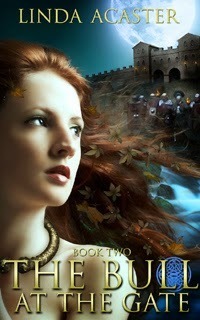 The Bull at the Gate, by Linda Acaster, is the second in the Torc of Moonlight trilogy of occult romantic thrillers. I read the first and have been waiting for this second with some impatience. It was worth the wait.
The Bull at the Gate, by Linda Acaster, is the second in the Torc of Moonlight trilogy of occult romantic thrillers. I read the first and have been waiting for this second with some impatience. It was worth the wait.Linda Acaster is a writer with talent. That she’s done research in depth for this book is clear. The detail, especially of the archaeology and history of York, is superb. I thought I knew the city, but I’ve learned things I never even suspected. York is, in fact, another character in the book.
The story is complex; an intertwining of present day events with those occurring in Roman York. And, ever-present, the raison d’être of hero Nick’s every move, is the enigmatic and mysterious entity that may or may not be Alice. The past returns to haunt Nick, literally, as he struggles to recover from the devastation of loss that occurred earlier in his life. To complicate matters, a new woman emerges uninvited into his life. Sophie is clearly a girl intent on a good time and, when she goes missing, her association with Nick places him in the field as a prime suspect with the local police.
Are Nick’s experiences real, imaginary, glimpses of another world and time, or the product of a damaged mind struggling with a past event too difficult to face? In weaving the tale, Linda Acaster keeps the reader guessing, providing clues but muddying the waters with an unreliable narrator.
Is this book crime, romance, historical, occult, or is it both a combination of these and something else entirely? And does it matter that it crosses genres? As a reader, such classification isn’t important to me. What matters is a gripping tale populated by characters I can empathise with and others I can thoroughly dislike. And this book provides exactly that. Had my circumstances been different, I would have read this at one sitting. As it was, I found myself eager to read it whenever time and opportunity allowed. I was driven to reach the end, to discover what would happen.
As with the first book in the series, this is a well-told tale with real depth and multiple themes explored in a unique style. And, as expected of a work of intelligence, it makes demands of the reader. There are several WTF? moments, times when the reader has to pause to consider, times when questions arise unanswered only to be clarified later in the story. I like that. Reading is far from a passive activity and Linda Acaster’s writing brings the occupation to life in a unique way.
I enjoyed the read and have no hesitation in recommending the book. And, let’s have the final book as soon as possible!Related articles
 The Bull At The Gate - Writing About Alternate Realities
The Bull At The Gate - Writing About Alternate Realities
 Contribution to Mankind, by Linda Acaster, Reviewed
Contribution to Mankind, by Linda Acaster, Reviewed
 Beneath the Shining Mountains, by Linda Acaster, Reviewed.
Beneath the Shining Mountains, by Linda Acaster, Reviewed.
 Guest-blogging in support of The Bull At The Gate
Guest-blogging in support of The Bull At The Gate

Published on March 16, 2014 02:42
March 14, 2014
Publishers: Surprisingly, Some Are Very Good.
 Dan Grubb, Publisher extraordinaire.In the Indie world, Publishers are pretty much rubbished. Let’s face it, the Big Boys generally do very little for authors. Unless you’re a ‘celebrity’ (whatever that means!) they treat you a like necessary evil, do the bare minimum to promote your hard work, and generally place barriers in the way of true creativity.
Dan Grubb, Publisher extraordinaire.In the Indie world, Publishers are pretty much rubbished. Let’s face it, the Big Boys generally do very little for authors. Unless you’re a ‘celebrity’ (whatever that means!) they treat you a like necessary evil, do the bare minimum to promote your hard work, and generally place barriers in the way of true creativity.How refreshing, then, to find a publisher who not only does none of these things, but who actively become engaged in the whole process, including promotion? On 30th March, Fantastic Books Publishing will simultaneously launch ebook and paperback editions of the first volume of my fantasy trilogy. A Seared Sky: Joinings, has been a labour of love over a number of years. The first book runs to 220,000 words, the second exceeds 200k and the third, currently in the final stages of editing, will top out around the same level. When an author expends that amount of energy, creativity, imagination and time in a project, he wants to be sure that publication is going to be a positive event. We write to be read, after all.
For many authors, their experience with indifferent, lazy, unconcerned publishers only truly chasing the promise of megabucks on the backs of ghost-written ‘celebrity’ trash, is enough to make them do it themselves. I’ve done it. 7 times. Self publishing can be fun, liberating, exciting and rewarding. It can also be incredibly frustrating, time-consuming and, ultimately, a route to insignificant sales. The book world, as we all know, is fiercely competitive, yet, at the same time, amongst authors, surprisingly supportive. The problem for the Indie author is exposure. Build a platform, they say: good advice for a carpenter wanting to proclaim his political views, I suppose. We hear it time and time again. And I’ve had a stab at it.
With over 9k followers on Twitter, 3.3k on Goodreads, 2.5k on LinkedIn, an author page on FB with 600 likes and a personal page with 1.8k, fingers in other pies, guest posts on other blogs, comments all over the place and membership of umpteen groups, that’s a pretty reasonable stab, isn’t it? (Sorry for that very convoluted sentence. BTW, should you wish to connect with me on any of those networks, click the link and join me there, please). But has this resulted in noticeable sales? In a word: no!
Perhaps my work is poor? Well, those who’ve read it and placed reviews don’t appear to think so. With mostly 5 star awards and positive reviews, almost exclusively from people I don’t know, the signs are that my writing is pretty good.
So, back to the publishing bit. Many writers are put off even approaching a publisher, because of all the negative publicity about the process, coupled with dubious success. But, as in all areas of life, it’s the exceptions that prove the rule. I was introduced to Fantastic Books Publishing, a small independent publisher, through one of my colleagues at Hornsea Writers, a supportive group of professional writers with their own blog, here.
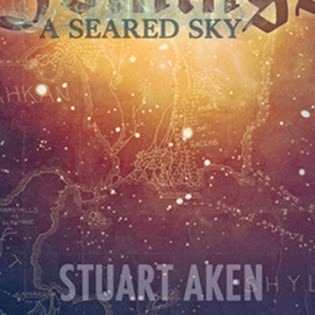 I sent them my precious MS, using their normal channels, and, lo and behold! Yes. Dan Grubb replied enthusiastically, asking for the whole thing. Since then, I’ve been treated as an equal partner in the venture. We each do those things that we’re best at. So, Dan sorted the final edits, is organising the promotional aspect, has engaged a professional cover artist who’s produced a brilliant cover (to be revealed in all it’s glory shortly before the launch). But, more than this, he’s produced a short video of an interview with me and is currently recording interviews with my characters. One of those you’ll find here. But, beware, Dagla Kaz is not a nice man!
I sent them my precious MS, using their normal channels, and, lo and behold! Yes. Dan Grubb replied enthusiastically, asking for the whole thing. Since then, I’ve been treated as an equal partner in the venture. We each do those things that we’re best at. So, Dan sorted the final edits, is organising the promotional aspect, has engaged a professional cover artist who’s produced a brilliant cover (to be revealed in all it’s glory shortly before the launch). But, more than this, he’s produced a short video of an interview with me and is currently recording interviews with my characters. One of those you’ll find here. But, beware, Dagla Kaz is not a nice man! The launch party, organised by my publisher (that sounds great, doesn’t it?) is being held online via Facebook so that I can connect with as many people worldwide as possible. You can access the party here, and, even if you don’t belong to FB, or maybe hate the network, you can still join in the fun on the day. I will, of course, also be presenting more information
 here and on some guest posts on other blogs in the run-up.
here and on some guest posts on other blogs in the run-up.My experience of working with this publisher has been entirely positive. Fantastic Books Publishing is run as the passion it truly is for Dan and his associates. I’ve been made to feel relevant, special, cherished and valued. This has been a far cry from the horror stories I’ve heard from other writers. So, you see, not all publishers are evil organisations run by bean-counters. This one is a company with heart and a true interest in the author and his work.Related articles
 A Fantastic Talk on Marketing.
A Fantastic Talk on Marketing.
 #Imagine: Penny Grubb Interviews Author Stuart Aken
#Imagine: Penny Grubb Interviews Author Stuart Aken

Published on March 14, 2014 04:11
March 8, 2014
The Bull At The Gate – Writing About Alternate Realities
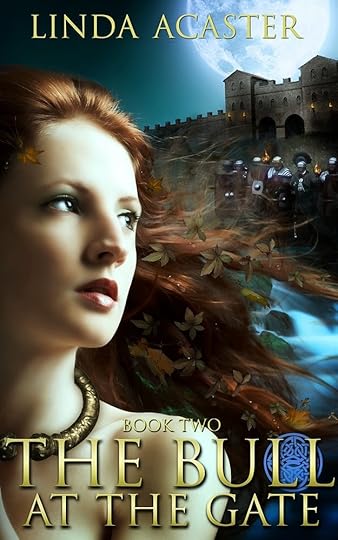 This weekend sees the launch of Linda Acaster’s
The Bull At The Gate
, Book 2 in the
Torc of Moonlight
trilogy of occult thrillers set in northern England. One of the challenges facing an author is writing with depth, and she’s visiting the blog to explain how she creates multi-layered fiction within a single book and across a trilogy. Do leave a query or comment as a copy of Books 1 & 2 will be awarded to one lucky person.
This weekend sees the launch of Linda Acaster’s
The Bull At The Gate
, Book 2 in the
Torc of Moonlight
trilogy of occult thrillers set in northern England. One of the challenges facing an author is writing with depth, and she’s visiting the blog to explain how she creates multi-layered fiction within a single book and across a trilogy. Do leave a query or comment as a copy of Books 1 & 2 will be awarded to one lucky person.~~Thanks, Stuart, for the welcome.
Ever witnessed an event alongside a friend and later listened, incredulous, to their account of what happened? And when you voiced your take on what occurred they stood open-mouthed staring at you? It’s all a matter of perception, and everyone’s perception is different.
I use this insight with varying emphasis throughout the Torc of Moonlight trilogy, which follows the resurrection of a Celtic water deity. Nick carries the novels. In Book 1 he’s nineteen, studying at Hull’s university, and like many of his age believes in the indestructibility of youth; Alice is his true love. Or is she? Is his perception coloured by events, both earthly and occult? The ambiguity is drip-fed from an early stage and encouraged by the use of a historical Prologue through which readers perceive the contemporary events.
This ambiguity is carried across to the two parallel storylines, one contemporary, one historical. Is a middle-aged tutor as lecherous as hearsay suggests? Why has he and a girlfriend from his younger days kept in touch if they bicker like an old married couple? Is the Romano-Briton a Gabrovantices Celt or as Roman as his name? What befell him in his own time to trap him in water he envisages as a blessed Pool, despite it now being no more than a muddy puddle?
As have many cultures, Celtic lore held the power of the indivisible three in high esteem. That number is woven throughout the three storylines, and is the reason for a trilogy rather than a series. Not until the ending of Book 1 does the unnamed deity make a true appearance, yet, like the power of the three, it has resonated within each storyline throughout the novel.
 In keeping, newly launched
The Bull At The Gate
opens three years after
Torc of Moonlight
closes and contains three storylines running parallel. Dragging himself from the grip of post traumatic stress syndrome, Nick moves to York to work at the university, arriving in February just as the Jorvik Viking Festival commences.
In keeping, newly launched
The Bull At The Gate
opens three years after
Torc of Moonlight
closes and contains three storylines running parallel. Dragging himself from the grip of post traumatic stress syndrome, Nick moves to York to work at the university, arriving in February just as the Jorvik Viking Festival commences.Yet beneath the city’s mediaeval minster cathedral sits the foundations of the Roman fortress that garrisoned the infamous Ninth Legion, and the Sixth Victrix. Across the river stood the colonia Eboracum, its Forum, public baths, temples and cemeteries now buried beneath a modern urban sprawl. For the Romans, Februalia is a time for cleansing, and a retired legionary has a pressing need to cleanse the Temple of Mithras. Christ-men are building their own temple and turning covetous eyes on both dressed stone and a spring sacred to the goddess Luna.
When a female student is reported missing, the police suspect Nick of being involved in her disappearance, and as events from Book 1 return to haunt him, he realises that it’s not PTSS that he’s been suffering. Trapped between worlds, Alice is trying to contact him, and in doing so she may have opened a portal that has closed around the missing girl. But who is going to believe that he’s not an over-enthusiastic historical re-enactor? Can Nick reach and free both the girl and Alice, and is it love or guilt that’s driving him?
Whose perception of reality is correct: the police who believe Nick needs psychiatric help? His work colleagues who think he’s trying to pass reproductions as true archaeological artefacts? The Roman who is convinced an Otherworldly force is bent on destruction of everything he holds dear?
Ambiguity need not slow a novel, but it does add depth because it makes the reader work. Get into the mind of each of your viewpoint characters and truly understand their perceived reality. Where does it state that one, or more, cannot be an unreliable narrator?
Book 3 of the Torc of Moonlight trilogy, currently being written, starts three years after the close of The Bull At The Gate , is set in another university city, Durham, and again has two contemporary and one historical storylines. A sense of symmetry creates a background resonance of its own.~~
Linda Acaster has written in a number of genres, and her back catalogue holds seven published books including a writers’ resource, over 70 short stories, and a plethora of articles for writers’ journals. Torc of Moonlight is currently discounted to 99p/99c. The Bull At The Gate is now available on Amazon and in all other eformats from Smashwords while distribution filters through to the iBooks, Nook, and Kobo stores. For more information visit her website.

Published on March 08, 2014 00:15
March 6, 2014
World Book Day (UK) Today
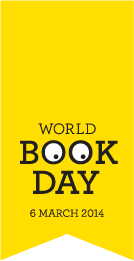 Just a quick reminder that today is World Book Day in UK. Here are a couple of links for those who
Just a quick reminder that today is World Book Day in UK. Here are a couple of links for those who want to get involved in this great enterprise aimed at improving literacy:
Reading Agency:
World Book Day
Published on March 06, 2014 03:17
March 5, 2014
The Book is on the Launchpad
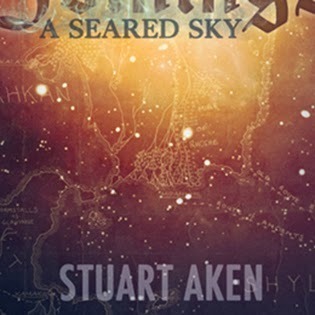 If you’re a regular visitor, you’ll know I’ve been signalling the approaching publication of my epic fantasy here from time to time. We now have a launch date.
If you’re a regular visitor, you’ll know I’ve been signalling the approaching publication of my epic fantasy here from time to time. We now have a launch date.On Sunday 30thMarch, Fantastic Books Publishing will launch A Seared Sky: Joinings, which is the first book in the trilogy. The picture is a hint at the cover.
There’s a launch party on Facebook. If you’d like to attend, click here and you’ll be whisked off to the spot, where you can investigate and add your name to those attending. The more the merrier. By the way, this is a virtual event, happening online, so you don't need to worry about your geographical location. But, for those of you who choose not to do the party thing, I’ll be adding links later on to guide you to places you can buy the book.
Over the intervening weeks, I’ll be posting bits and pieces relating to the book, so watch this space.
In the meantime, I’m aware that many readers have invested in initial books for trilogies only to discover that the author has run out of steam. You won’t have that problem with my book. I’ve already written all 3 volumes and edited the first 2. And, I’m currently doing the penultimate edit of book 3 as each chapter comes back from the beta readers. Fantastic BooksPublishing, of course, do the final edit prior to publication.

Published on March 05, 2014 02:00



